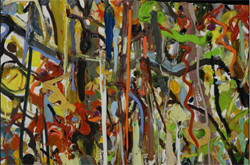The exhibition “Space, Unlimited” explores various forms and representations of “space,” which unsurprisingly proves an incredibly broad subject to tackle. Environmental habitats, historical landscapes, and personal narratives are among the artistic interpretations of the evidently “unlimited” concept on display at the Art Museum of the Americas. Though a seemingly disjointed assemblage of artists who have little in common aside from their nationality, the exhibition provides thoughtful commentary on the cultural, architectural, and artistic histories of Venezuela and Puerto Rico.
 The entrance to the exhibit is uninviting, as the viewer is assaulted by a hideous noise emitted from behind closed curtains. Don’t be alarmed: it is merely the sound of nature—the ugly squawking of a tropical parrot—which provides the soundtrack to Magdalena Fernández’s video installation “Ara Ararauna (1pm006)”. Drawing on Mondrian’s famous geometric paintings, the film takes on the form of three squares which warp their shapes in response to the squawks of the parrot. The opening work is one of the exhibit’s weakest; visually, Magdalena’s video isn’t incredibly innovative, and the parrot sounds are, frankly, distracting.
The entrance to the exhibit is uninviting, as the viewer is assaulted by a hideous noise emitted from behind closed curtains. Don’t be alarmed: it is merely the sound of nature—the ugly squawking of a tropical parrot—which provides the soundtrack to Magdalena Fernández’s video installation “Ara Ararauna (1pm006)”. Drawing on Mondrian’s famous geometric paintings, the film takes on the form of three squares which warp their shapes in response to the squawks of the parrot. The opening work is one of the exhibit’s weakest; visually, Magdalena’s video isn’t incredibly innovative, and the parrot sounds are, frankly, distracting.
Fortunately, the exhibit gets better from there. Angela Bonadies takes a more personal look at space in her photographic series, “Cosas que hablan (Things that Speak)”. She explores her subjects’ relationships to their surrounding objects and domestic habitats, creating a somewhat disturbing cluttering of material forms that evokes the Latin artistic tradition of horror vacui, the fear of empty spaces. Even more disturbing is her photograph, “El fantasma del ornitólogo (The Ornithologist’s Phantom),” which depicts a young bird collector in his workplace, amidst taxidermied bird corpses and a dreamlike sequence of suspended plastic birds. Like much of Bonadies’s work, the piece blends an element of fantasy into the otherwise morbid display.
The diversity of the work on display makes for an interesting collection. The layout of the museum provides each artist his or her own room, allowing the viewer to take in each artist individually. Without distraction, one can read through the chaotic texts of Nayda Collazo-Llorens’ ESCaperucita & Little Red Flying Hood, a bilingual narrative of a same-sex couple who take a turbulent journey from Puerto Rico to New York. Using Morse code and a visual frenzy of words, Collazo-Lloren’s work creates a “visual noise,” one which thankfully drowns out the parrot in the background.
The final sculptural installation by the artist collective Guerra de la Paz is perhaps the most impressive in the exhibit. The group of artists constructed a tree out of discarded clothing, meshing earthy tones to build a soft sculpture which blooms at the ceiling in brighter hues of red and pink. The installation occupies the entire space of the room and is accompanied by the sounds of a soothing forest of chirping birds and insects. Although the serene ambiance of the display can lull the viewer into a deep, peaceful trance, the work also calls attention to the excessive material waste that contributes to the beautiful tree. However, the result of this recycled sculpture is a work of art almost as lovely as nature itself, evoking a painterly quality in the individual tones of each piece of cloth which contributes to the work.
It is difficult to make any profound connections between many of the artists who contributed to the exhibit. The individual works do more to entice the viewer than the overarching theme of “Space, Unlimited” ever could. With only a few exceptions, the participating artists offer insightful commentary on the environment, their personal narratives, and the mediums in which they work. Though the collection may give a disjointed glimpse into the visual expressions of Puerto Rican and Venezuelan artists, the pieces ultimately reflect the struggles of contemporary artists from these nations face in forging their own identity in a post-modern world largely dominated by Western artwork.
Art Museum of the Americas is located at 201 18th Street, NW. “Space, Unlimited” will be showing through April 12, 2009.




